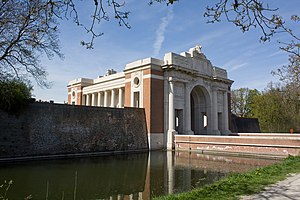Menin Gate Memorial
| Menin Gate Memorial to the Missing | |
|---|---|
| Commonwealth War Graves Commission | |

The Menin Gate
|
|
| For the missing of Commonwealth nations (except New Zealand and Newfoundland) who died in the Ypres Salient during the First World War. | |
| Unveiled | 24 July 1927 |
| Location |
50°51′08″N 02°53′30″E / 50.85222°N 2.89167°ECoordinates: 50°51′08″N 02°53′30″E / 50.85222°N 2.89167°E near Ypres, West Flanders, Belgium |
| Designed by | Reginald Blomfield |
|
Total commemorated
|
54,896 |
| Burials by nation | |
|
|
| Burials by war | |
|
World War I: 54,896
|
|
|
To the armies of the British Empire who stood here from 1914 to 1918 and to those of their dead who have no known grave
|
|
| Statistics source: Cemetery Details. Commonwealth War Graves Commission. | |
The Menin Gate Memorial to the Missing is a war memorial in Ypres, Belgium, dedicated to the British and Commonwealth soldiers who were killed in the Ypres Salient of World War I and whose graves are unknown. The memorial is located at the eastern exit of the town and marks the starting point for one of the main roads out of the town that led Allied soldiers to the front line. Designed by Sir Reginald Blomfield and built and maintained by the Commonwealth War Graves Commission, the Menin Gate Memorial was unveiled on 24 July 1927.
In medieval times, the original narrow gateway on the eastern side of the city of Ypres was called the Hangoartpoort, "poort" being the Dutch word for gate. In order to prosper and maintain its wealth, the city of Ypres had to be fortified, to keep out potential invaders. During the 17th and 18th centuries, while under the occupation of the Habsburgs and the French, the city was increasingly fortified. Major works were completed at the end of the 17th century by the French military engineer Sebastien Le Prestre, Seigneur de Vauban. At the outbreak of the First World War in August 1914, the eastern exit simply cut through the remains of the ramparts and crossed a moat. The gateway was by this time known as the Menenpoort, or Menin Gate in English, because the road leading through the gateway led to the small town of Menen.
Ypres occupied a strategic position during the First World War because it stood in the path of Germany's planned sweep across the rest of Belgium, as had been called for in the Schlieffen Plan. By October 1914, the much battered Belgian Army broke the dykes on the Yser River to the north of the City to keep the western tip of Belgium out of German hands. Ypres, being the centre of a road network, anchored one end of this defensive feature and was also essential for the Germans if they wanted to take the Channel Ports through which British support was flooding into France. For the Allies, Ypres was also important because it eventually became the last major Belgian town that was not under German control.
...
Wikipedia
